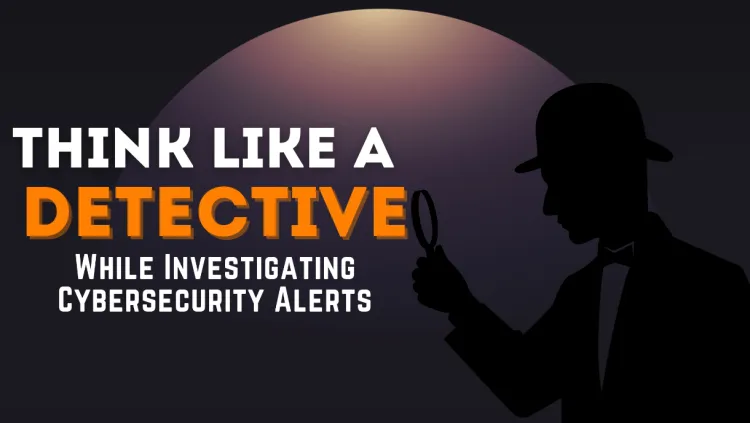Investigating Cybersecurity Alerts Like a Detective
Investigating cybersecurity alerts requires a detective-like mindset. By gathering evidence, analyzing patterns, and thinking critically, professionals can uncover and respond to threats effectively. Key skills include attention to detail, pattern recognition, and analytical thinking. Following a step-by-step approach—collecting data, assessing threat severity, and responding methodically—helps ensure accurate investigations. Incorporating tools like threat intelligence and automation further enhances efficiency while documentation and teamwork strengthen overall security efforts.

In the world of cybersecurity, investigating alerts often feels like solving a mystery. Much like a detective piecing together clues, cybersecurity professionals must gather data, analyze patterns, and uncover the truth hidden in system logs and security alerts. As cybersecurity threats continue to evolve, the ability to think critically and methodically becomes crucial in defending against them.
In this blog, we’ll explore how adopting a detective mindset can enhance your ability to investigate cybersecurity alerts effectively and respond to potential threats more swiftly.
The Detective’s Mindset in Cybersecurity
When investigating cybersecurity alerts, adopting the mindset of a detective can lead to more thorough and accurate findings. A good detective doesn’t jump to conclusions based on a single piece of evidence. Instead, they gather all available clues, analyze them, and form a hypothesis. This approach is equally effective in responding to cybersecurity alerts.
Key Skills of a Cyber Detective
- Attention to Detail: Just like a detective observes every small clue, cybersecurity professionals must examine every detail in alerts, such as timestamps or IP addresses.
- Critical Thinking: Ask essential questions, such as:
- Is this alert part of a larger attack?
- What’s unusual about this event?
- Pattern Recognition: Detectives identify patterns in criminal behavior; similarly, spotting trends in security events or data breaches can reveal valuable insights.
- Analytical Thinking: A logical, step-by-step investigation is key to identifying the root cause of an issue.
How to Investigate Cybersecurity Alerts Like a Detective
Step 1: Gather the Evidence
When a cybersecurity alert appears, your first step is to collect as much data as possible. Analyze system logs, network traffic, and other available resources. A detective would never rely on one clue alone, and neither should you.
Step 2: Assess the Severity of the Threat
Not all alerts are created equal. Some may be false positives, while others indicate critical threats. Assess the situation by asking:
- Is this alert related to a known vulnerability?
- Has this kind of attack occurred before?
- Is the activity from a trusted source or an untrusted IP?
Step 3: Investigate and Follow the Trail
Once you understand the alert’s severity, start investigating. Follow logs, communications, or other clues to uncover the root cause. Like a detective tracking a suspect, you might explore multiple leads before discovering the correct one.
Step 4: Analyze Patterns and Correlations
Look for patterns or correlations across multiple alerts. Are there other incidents indicating a broader threat? Is there a timeline of suspicious activities? Correlating data provides a clearer picture of the attack.
Step 5: Respond and Close the Case
After gathering all facts and identifying the cause, respond swiftly. Your response might include:
- Blocking an IP address
- Isolating infected machines
- Implementing new security measures
Best Practices for Investigating Cybersecurity Alerts
- Use Threat Intelligence: Leverage tools to link alerts to known attack patterns.
- Automate Where Possible: Use automation for common threats, freeing time for complex investigations.
- Document Everything: Maintain detailed records of your process, just like detectives do with case files.
- Collaborate with the Team: Share findings and suspicions with your team to resolve issues faster.
The Role of Forensic Analysis in Cyber Investigations
Forensic analysis in cybersecurity mirrors a detective’s examination of a crime scene. It involves analyzing devices, networks, and logs to uncover evidence of malicious activity. Strong forensic skills allow professionals to:
- Trace the origin of an attack
- Understand its impact
- Strengthen defenses against future incidents
Conclusion
Investigating cybersecurity alerts requires more than technical expertise—it demands a detective-like mindset. By thinking critically, gathering evidence, recognizing patterns, and responding methodically, you can uncover and mitigate threats efficiently. Whether you’re a seasoned cybersecurity professional or just starting, adopting this approach will enhance your investigative skills and strengthen your organization’s security posture.
FAQs
-
What is the first step in investigating a cybersecurity alert?
Gather all available data, including system logs and network traffic, related to the alert. -
How do I determine if a cybersecurity alert is serious or a false positive?
Assess the source of the alert, behavior patterns, and any historical context. -
How can pattern recognition help in cybersecurity investigations?
Recognizing patterns in previous incidents or attack behaviors can help identify and respond to similar threats. -
Should I always respond immediately to cybersecurity alerts?
Not always. Assess the alert’s severity to determine the appropriate response time. -
What tools assist in investigating cybersecurity alerts?
Tools like SIEM systems, threat intelligence platforms, and network monitoring tools are invaluable. -
How do I prioritize multiple alerts?
Base prioritization on the severity of the threat, the systems affected, and potential impact. -
What is threat intelligence, and how does it help in investigations?
Threat intelligence offers context on known cyber threats, enabling quicker identification and response. -
How do I document my investigation process?
Record every step, from data reviewed to actions taken. This ensures compliance and future reference. -
Can a cybersecurity alert indicate multiple problems?
Yes, a single alert could be part of a chain of events or reveal multiple issues. -
How can I improve my cybersecurity investigation skills?
Practice analyzing logs, review past incidents, stay updated on threats, and participate in training exercises.












![Top 10 Ethical Hackers in the World [2025]](https://www.webasha.com/blog/uploads/images/202408/image_100x75_66c2f983c207b.webp)

![[2025] Top 100+ VAPT Interview Questions and Answers](https://www.webasha.com/blog/uploads/images/image_100x75_6512b1e4b64f7.jpg)









